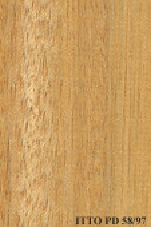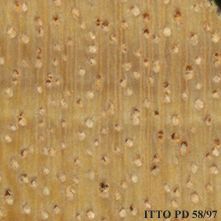
AIéLé (Canarium schweinfurthii)
Trade Name
Aiélé
Scientific Name
Canarium schweinfurthii Engl.
Family
BURSERACEAE
Common Names
Billi (Sierra Leone); Eyere (Ghana); Bediwuana (Ghana); Aiélé (Côte d`Ivoire); African canarium (United Kingdom); Canarium (Germany); Aiélé (Germany); Mbidikala (Zaire); Bidikala (Zaire); Ovili (Gabon); Abeul (Gabon); Abë (Equatorial Guinea); Mbili (Congo); Abel (Cameroon); Mwafu (Uganda); Mbili (Angola); Aiélé
Scientific Name Synonyms
Canarium velutinum Guillemin; Canarium thollonianum Guillemin; Canarium occidentale A. Chev.
Description Of The Tree
Botanical Description
The tree reaches a height of 46 m, with a trunk diameter up to 150 cm. The boles attains 25 m and more in length.
Natural Habitat
Canarium schweinfurthii occurs chiefly in moist equatorial forests.
Natural Distribution
From Sierra Leone to Sudan, to Angola and to Tanganyika Lake.
Wood Identification
Anatomic Description Of Wood
Wood diffuse porous. Occasionally vessels exclusively solitary (over 90%). Tangential diameter of vessel lumina 200 micras or more (large). Tyloses thin walled. Non-vestured pits. Vessels per mm2 less than 6 (rare). Simple perforation plates. Vessel-ray pits coa Paratracheal axial parenchyma scanty and/or vasicentric. 4 to 10 rays per mm (medium). Rays non-storied. Rays 1 to 4 seriate. Silica bodies in upright and/or square ray cells. Body ray cells procumbent with one row of upright and/or square marginal cells (Kribs-III). Septate fibers present. Fibers with simple to minutely bordered pits.
-
 Wood Macro Photo Radial Plane
Wood Macro Photo Radial Plane
-
 Wood Micro Photo Of Transversal Section
Wood Micro Photo Of Transversal Section
Availability
Cites Status
Unrestricted
General Wood Description
Odor
Light and pleasant odor.
Color
The sapwood is white to pale straw, it has a thickness of up to 10 cm. The heartwood is pale pinkish brown to light pinkish yellow, it is not clearly demarcated.
COLOR INDEX (1=Black, 7=Light yellow,white)
5
Grain
The grain is highly and systematically interlocked; special care is needed when drying because of frequent risks of distortion.
Texture
This wood has a somewhat coarse texture.
Natural Durability
Not durable; important risks of decay attacks at any processing step, from logs up to final products. It must receive preservative treatment. Sensible to termites attack. Heartwood is sensible to Lyctus attacks.
Natural durability index (1= Very high durability, 7=Vey low durability)
5
Internal Growth Stresses
No growth stresses are reported in this species.
Silica Content
Silica Content: It is reported to have silica. Contents over 0.05% may affect wood processing. Silica Value: 0.12
Resistance To Impregnation
Nearly impossible to treat with a too much low penetration of the preservative substances.
Wood Physical Properties
Basic Density or Specific Gravity (O.D. weight/vol. green) (g/cm³)
0.45
Air-dry Density (Weight and volume at 12%MC) (g/cm³)
0.49
Total shrinkage Tangential (Saturated to 0%MC) (%)
9.9
Total shrinkage Radial (Saturated to 0%MC) (%)
5.9
Drying Defects
Ease of Drying: The wood is easy to air dry and kiln dry. Drying Defects: Sometimes it is liable to develop fine long surface cracks.
Recommended Dry Kiln Schedule
FR-11
Dimensional stability ratio (Total Tangential Shrinkage %/Total Radial Shrinkage %)
1.7
Wood Chemical Properties
Wood Mechanical Properties
Bending Strength (MOR),12%MC (kgf/cm²)
596
Stiffness (MOE) 12%MC (kgf/cm²)
106948
Compression parallel to fiber 12%MC (kgf/cm²)
368
Compression perpendicular to fiber 12%MC (kgf/cm²)
41
Shear strength radial 12%MC (kgf/cm²)
65
Janka hardness (side) 12%MC (kgf)
290
Janka hardness (end grain) 12%MC (kgf)
390
Workability
Sawing
It is easy to saw.
Rotary Veneer Cutting
Suitable for peeling without treatment.
Sliced Veneer
Suitable for peeling without treatment.
Blunting Effect
Moderate blunting effect; stellited blades for sawing and carbide tools for machining are advised.
Machining
Possible difficulties caused by interlocked grain are reported.
Planing
Easy; no particular problems.
Moulding
Easy; no particular problems.
Boring
Easy; no particular problems.
Mortising
Easy; no particular problems.
Nailing
No particular problem.
Gluing
Glues well if basic gluing technical rules are followed.
Sanding
Difficult to obtain very good results because of interlocked grain.
Polishing
Needs pre-coating.
Steam Bending
Steam bending is difficult.
Response To Hand Tools
No particular problems.
REFERENCED USES
End Uses Summary
HOUSING GENERAL, boards, frames, steps, panelling, fittings, shutter boards, FURNITURE AND CABINETS, common furniture, PLYWOOD AND VENEER, faces, cores, PACKING, heavy packing, pallets, OTHER AND MUSICAL INSTRUMENTS, wheel, door core, coffin
General Housing
- 10 - Silica in Timbers
Boards
- 13 - Dry kiln schedules for commercial woods. Temperate and tropical. Section III. Latin American (Mexico, Central, and South America) Woods–Conventional Temperatures
Frames
- 16 - Woods of the World
Steps
- 17 - Tree Conservation Database
Paneling
- 18 - W3TROPICOS Missouri Botanical Garden
Fittings
- 19 - Silica in Timbers
Shutter Boards
- 20 - Prospect: The wood database
Furniture Cabinets
- 21 - Tropical timbers of the world. Part III-Southeast Asian and Oceanian Species.
Furniture, Common
- 23 - Handbook of Hardwoods
Panels, Veneers
- 25 - Directory of Timber Trade Malaysia
Faces
- 26 - Annual Review and Assessment of the World Timber Situation 1998-ITTO
Cores
- 27 - Embassy of Brazil in Japan
Packing
- 45 - Recopilación y Análisis de Estudios Tecnológicos de Maderas Peruanas
Heavy Packing
- 47 - Arvores Brasileiras
Pallets
- 48 - The strength properties of timbers
Wheels
- 75 - Tropenholzer
Door Cores
- 76 - Descripción General y Anatómica de 105 Maderas del Grupo Andino.
Coffin
- 78 - Amazonian Timbers for the International Market
Please Provide Information To View Producer Information